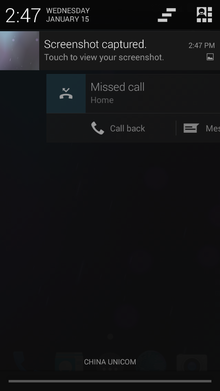Interface
Notifications are accessed by sliding from the top of the display;
individual notifications can be dismissed by sliding them away, and may
contain additional functions as seen on this example of the "missed
call" notification from an older version of Android.
Android devices boot to the homescreen, the primary navigation and information "hub" on Android devices that is analogous to the desktop found on personal computers. (Android also runs on regular personal computers, as described below). Android homescreens are typically made up of app icons and widgets; app icons launch the associated app, whereas widgets display live, auto-updating content, such as the weather forecast, the user's email inbox, or a news ticker directly on the homescreen.[52] A homescreen may be made up of several pages, between which the user can swipe back and forth, though Android's homescreen interface is heavily customisable, allowing users to adjust the look and feel of the devices to their tastes.[53] Third-party apps available on Google Play and other app stores can extensively re-theme the homescreen, and even mimic the look of other operating systems, such as Windows Phone.[54] Most manufacturers, and some wireless carriers, customise the look and feel of their Android devices to differentiate themselves from their competitors.[55] Applications that handle interactions with the homescreen are called "launchers" because they, among other purposes, launch the applications installed on a device.
Along the top of the screen is a status bar, showing information about the device and its connectivity. This status bar can be "pulled" down to reveal a notification screen where apps display important information or updates, such as a newly received email or SMS text, in a way that does not immediately interrupt or inconvenience the user.[56] Notifications are persistent until read (by tapping, which opens the relevant app) or dismissed by sliding it off the screen. Beginning on Android 4.1, "expanded notifications" can display expanded details or additional functionality; for instance, a music player can display playback controls, and a "missed call" notification provides buttons for calling back or sending the caller an SMS message.[57]
Android provides the ability to run applications that change the default launcher, and hence the appearance and externally visible behaviour of Android. These appearance changes include a multi-page dock or no dock, and many more changes to fundamental features of the user interface.[58]

Tidak ada komentar:
Posting Komentar